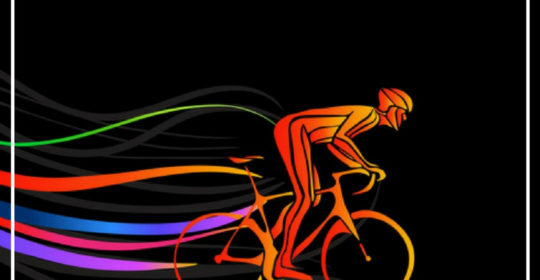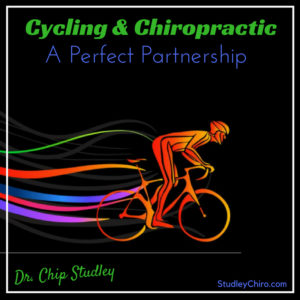
Chiropractic and Cycling – a perfect partnership.
 The Sacramento region is one of the best places in the entire U.S. for avid sports cyclists and fun riders alike, with scores of miles of trails, plenty of scenic rolling hills leading into the Sierras, and a prevalent bicycle culture in places like Davis, midtown, and East Sacramento.
The Sacramento region is one of the best places in the entire U.S. for avid sports cyclists and fun riders alike, with scores of miles of trails, plenty of scenic rolling hills leading into the Sierras, and a prevalent bicycle culture in places like Davis, midtown, and East Sacramento.As a Doctor of Chiropractic, I can treat a lot of the common injuries and even more serious trauma from accidents that occur while on two wheels. Today, I’ll share some general information with you, but feel free to contact me with any questions or make an appointment to come see me.
Fast facts about cycling in the U.S.A.:
Last year, about 59.67 million Americans (about 12.4% of the population) peddled to work, school, or just for fun on a regular basis.
In fact, over the last twenty years, the number of bicycle rides we take has more than doubled, from 1.8 billion to 4 billion annually!
What kind of bicycles do we ride?
30% mountain bike
28% road bike
18% hybrid, and
17% touring bike
Why do people ride bikes?
26% Recreation
23.6% Exercise
14.2% Commute
13.9% Personal errands and around the neighborhood
10% Visit a friend/bike with friends
Etc.
Where do people most commonly ride their bike?
48.1% Paved roads and surface streets
13.6% Sidewalks
13.1% Bicycle Paths
12.8% Shoulder of paved roads
5.2% Bike lanes
2.1% Unpaved roads
Here are some facts on the use and effectiveness of bike helmets:
Helmets reduce the risk of head injury and trauma by 85%, brain injury by 88%, and severe brain injury by more than 75%.
91% of bicyclists killed every year in accidents were not wearing a safety helmet.
Cycling accidents and brain injuries:
In fact, two-thirds of accidental deaths are caused by traumatic brain injuries.
And 1 in 8 cyclists with serious injuries also has a traumatic brain injury, although their too-often go undiagnosed or treated.
For avid cyclists logging long and arduous miles, here are the most common injuries due to overuse:
48.8% Neck
41.7% Knee
36.1% Groin/Buttocks
31.3% Hands
30.3% Lower back
Bike safety laws and rules of the road:
19 States have already passed laws that require motorists to stay at least three feet clear of bicyclists at all times while sharing the road.
Common cycling injuries:
From the weekend warrior to the daily commuter and the serious athlete cyclist, we see a wide array of injuries from cycling.
Whether it’s due to inadequate training, overuse, improper or ill-sized equipment, or bad cycling form, injuries are common. Additionally, bicycle crashes and accidents are extremely serious – especially when at high speeds or in traffic.
In fact, injuries incurred while bicycling result in 580,000 emergency room visits every year!
The most common ailment, pain, and injuries from cycling include:
• Lower back pain
• Neck pain
• Knee pain
• Hip pain
• Foot pain
I will make a few notes of each of those in relation to cycling here:
Lower back pain
Of course, all of those hours hunched over the handlebars can put a lot of stress on the lower back, especially the piriformis muscle, which stretches from the lower back down to the upper part of the thigh).
While this may manifest as back pain, cyclists also may experience pain or discomfort in the hip or even leg if the sciatic nerve is irritated when the piriformis is too tight.
Knee pain
While knee pain occurs fairly frequently on a bicycle, there are actually several causes of it such as overuse, falls and accidents, or more. In fact, knee injuries like ligament sprains, patellofemoral pain syndrome, and iliotibial band syndrome are the most common cycling injuries.
But when cyclists experience knee pain, it can also be because their bike is ill-fitting, or not suited to their dimensions and body.
These may affect the patella (or cap of the knee) joint, as it can be displaced either while cycling or during a fall.
However, if you experience pain at the front of your knee (posterior knee pain), it usually means that your seat is simply too low. But if you feel pain behind the knee (anterior), it probably signals that the seat is too high and straining your hamstrings.
Neck, arm, wrist, and hand pain
Neck pain often arises in a rider, which is often a sign that the bike’s handlebars are too low, and their neck is hyperextended as they look up. General pain can also be caused when too much pressure is transmitted throughout the upper body because of weight imbalance from awkward positioning.
Ideally, only about 40 percent of a cyclist’s bodyweight is positioned at the front of the bike, and the other 60 percent comfortably “sitting” in the back.
Leaning too far forward with your weight is also a reason for wrist pain, as pressure is placed on the arms and wrists against the handlebars. If the handlebar is also at an incorrect angle or too far away for the rider’s arm span, discomfort or injury can occur. If you feel this, then try compact or shallow drop handlebars to see if they are more comfortable and exert less pressure on the arms and wrists.
Cyclists also may experience problems with their hands or fingers, like compression of the median nerve (carpal tunnel syndrome) or handlebar palsy (Ulnar neuropathy).
Foot and ankle pain
Your feet and ankles gain a lot of wear and tear when cycling long miles, and pressure on the nerves will often spread to the ball of the foot and toes, a condition called “Hot Foot” by competitive bicyclists. Sprains, abrasions, and contusions of ankles – especially during falls – are also common.
Chiropractic treatment can help treat injuries from cycling and boost performance!
Whether you feel back, knee, or wrist pain, suffered a bad crash or accident, or just want to improve your athletic performance and recovery, chiropractic care may be of assistance. In fact, almost all professional cyclists regularly see a chiropractor for adjustments.
If you have been in a bike accident, treat it the same as a car crash and come see me or your M.D. immediately. And if you have lingering pain or discomfort, make an appointment – and bring our bicycle to my office!
Leave a reply 


Leave a reply